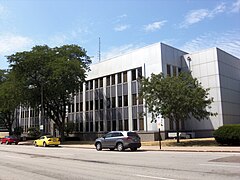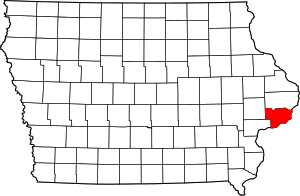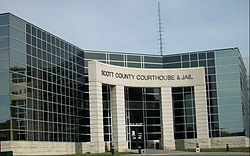Scott County, Iowa
Scott County | |
|---|---|
U.S. county | |
 | |
 Seal | |
 Location within the U.S. state of Iowa | |
 Iowa's location within the U.S. | |
| Coordinates: 41°38′09″N 90°38′02″W / 41.635833333333°N 90.633888888889°W | |
| Country | |
| State | |
| Founded | 1837 |
| Named for | Winfield Scott |
| Seat | Davenport |
| Largest city | Davenport |
| Area | |
| • Total | 468 sq mi (1,210 km2) |
| • Land | 458 sq mi (1,190 km2) |
| • Water | 10 sq mi (30 km2) 2.2% |
| Population (2020) | |
| • Total | 174,669 |
| • Density | 370/sq mi (140/km2) |
| Time zone | UTC−6 (Central) |
| • Summer (DST) | UTC−5 (CDT) |
| Congressional district | 2nd |
| Website | www |
Scott County is a county located in the U.S. state of Iowa. As of the 2020 census, the population was 174,669,[1] making it the third-most populous county in Iowa. The county seat is Davenport.[2]
Scott County is included in the Davenport–Moline-Rock Island, IA–IL Metropolitan Statistical Area.[3]
History[]

The first American settlement in the area now known as Scott County was Clark's Ferry or Clark's Landing (now Buffalo) in 1833. Other early towns included Davenport (now the county seat and largest city) and the town of Rockingham (which ceased to exist in 1847). The area was fully surveyed in 1837, and the county was established by the Wisconsin territorial legislature in that same year. Scott County is named for General Winfield Scott,[4] who was the presiding officer at the signing of the peace treaty ending the Black Hawk War.
By 1900 the population of the county was 51,500, and by 1950 it was over 100,000. Scott County now comprises part of the Quad City region, which includes the cities of Davenport and Bettendorf (in Iowa) and Rock Island, Moline and East Moline (in Illinois).
The present Scott County Courthouse was completed in 1955 and expanded along with the jail in 2007.[5][6] The old section of the Scott County Jail was listed on the National Register of Historic Places in 1983.[7] The courthouse was included as a contributing property in the Davenport Downtown Commercial Historic District in 2020.[8]
Geography[]
According to the U.S. Census Bureau, the county has a total area of 468 square miles (1,210 km2), of which 458 square miles (1,190 km2) is land and 10 square miles (26 km2) (2.2%) is water.[9]
Major highways[]
 Interstate 74
Interstate 74 Interstate 80
Interstate 80 Interstate 280
Interstate 280 U.S. Route 6
U.S. Route 6 U.S. Route 61
U.S. Route 61 U.S. Route 67
U.S. Route 67 Iowa Highway 22
Iowa Highway 22 Iowa Highway 130
Iowa Highway 130
Adjacent counties[]
- Clinton County (north)
- Rock Island County, Illinois (east and south)
- Muscatine County (southwest)
- Cedar County (northwest)
Demographics[]
| Historical population | |||
|---|---|---|---|
| Census | Pop. | %± | |
| 1850 | 5,986 | — | |
| 1860 | 25,959 | 333.7% | |
| 1870 | 38,599 | 48.7% | |
| 1880 | 41,266 | 6.9% | |
| 1890 | 43,164 | 4.6% | |
| 1900 | 51,558 | 19.4% | |
| 1910 | 60,000 | 16.4% | |
| 1920 | 73,952 | 23.3% | |
| 1930 | 77,332 | 4.6% | |
| 1940 | 84,748 | 9.6% | |
| 1950 | 100,698 | 18.8% | |
| 1960 | 119,067 | 18.2% | |
| 1970 | 142,687 | 19.8% | |
| 1980 | 160,022 | 12.1% | |
| 1990 | 150,973 | −5.7% | |
| 2000 | 158,668 | 5.1% | |
| 2010 | 165,224 | 4.1% | |
| 2020 | 174,669 | 5.7% | |
| U.S. Decennial Census[10] 1790-1960[11] 1900-1990[12] 1990-2000[13] 2010-2019[14] | |||

The US Census Bureau estimated Scott County's population at 170,385 in 2013, fourth fastest-growing out of Iowa's 99 counties after Dallas County, a western suburb of Des Moines: Johnson, Polk, followed by Warren County being the top five.[15]
2020 census[]
The 2020 census recorded a population of 174,669 in the county, with a population density of 373.8768/sq mi (144.3547/km2). 92.61% of the population reported being of one race. 72.51% were non-Hispanic White, 8.08% were Black, 6.92% were Hispanic, 0.33% were Native American, 2.78% were Asian, 0.03% were Native Hawaiian or Pacific Islander and 9.33% were some other race or more than one race. There were 77,771 housing units, of which 71,628 were occupied.[1]
2010 census[]
The 2010 census recorded a population of 165,224 in the county, with a population density of 360.806/sq mi (139.3081/km2). There were 71,835 housing units, of which 66,765 were occupied.[16]
2000 census[]

At the 2000 census there were 158,668 people, 62,334 households, and 41,888 families in the county. The population density was 346 people per square mile (134/km2). There were 65,649 housing units at an average density of 143 per square mile (55/km2). The racial makeup of the county was 88.54% White, 6.11% Black or African American, 0.32% Native American, 1.58% Asian, 0.02% Pacific Islander, 1.64% from other races, and 1.80% from two or more races. 4.06%.[17] were Hispanic or Latino of any race.
Of the 62,334 households 33.20% had children under the age of 18 living with them, 52.30% were married couples living together, 11.40% had a female householder with no husband present, and 32.80% were non-families. 26.90% of households were one person and 9.00% were one person aged 65 or older. The average household size was 2.49 and the average family size was 3.04.
The age distribution was 26.50% under the age of 18, 9.30% from 18 to 24, 29.40% from 25 to 44, 23.00% from 45 to 64, and 11.80% 65 or older. The median age was 35 years. For every 100 females, there were 95.80 males. For every 100 females age 18 and over, there were 92.50 males.
The median household income was $42,701 and the median family income was $52,045. Males had a median income of $38,985 versus $25,456 for females. The per capita income for the county was $21,310. About 7.70% of families and 10.50% of the population were below the poverty line, including 13.70% of those under age 18 and 5.80% of those age 65 or over.
Communities[]

Cities[]
- Bettendorf
- Blue Grass
- Buffalo
- Davenport
- Dixon
- Donahue
- Durant
- Eldridge
- Le Claire
- Long Grove
- Maysville
- McCausland
- New Liberty
- Panorama Park
- Princeton
- Riverdale
- Walcott
Census-designated places[]
Other unincorporated communities[]
Townships[]
Former township[]
Population ranking[]
The population ranking of the following table is based on the 2020 census of Scott County.[1]
† county seat
| Rank | City/town/etc. | Municipal type | Population (2020 Census) |
|---|---|---|---|
| 1 | † Davenport | City | 101,724 |
| 2 | Bettendorf | City | 39,102 |
| 3 | Eldridge | City | 6,726 |
| 4 | Le Claire | City | 4,710 |
| 5 | Park View | CDP | 2,709 |
| 6 | Durant (partially in Cedar and Muscatine counties) | City | 1,871 |
| 7 | Blue Grass (partially in Muscatine County) | City | 1,666 |
| 8 | Walcott (partially in Muscatine County) | City | 1,551 |
| 9 | Buffalo | City | 1,176 |
| 10 | Princeton | City | 923 |
| 11 | Long Grove | City | 838 |
| 12 | Riverdale | City | 379 |
| 13 | Donahue | City | 335 |
| 14 | McCausland | City | 313 |
| 15 | Dixon | City | 202 |
| 16 | Maysville | City | 156 |
| 17 | Panorama Park | City | 139 |
| 18 | New Liberty | City | 138 |
Politics[]
For most of its history, Scott County was primarily a Republican county. From 1880 to 1984, it only supported a Democrat for president nine times, six of which were national Democratic landslides. In more recent elections, the county has become consistently Democratic in presidential elections like many other midsize urban counties nationwide, with the party's candidates winning the county in every presidential election from 1988 on. However, their margins of victory have not been as wide as in many other counties of similar composition, especially in 2016 when Hillary Clinton only won the county by 1,291 votes.
Education[]
Public school districts in Scott County include:
- Bettendorf Community School District, Bettendorf
- Calamus–Wheatland Community School District, Wheatland
- Davenport Community School District, Davenport
- Durant Community School District, Durant
- North Scott Community School District, Eldridge
- Pleasant Valley Community School District, Riverdale, Bettendorf, LeClaire
Higher education institutions[]
- Scott Community College is located in Riverdale
- Saint Ambrose University is located in Davenport
See also[]
- National Register of Historic Places listings in Scott County, Iowa
- Upper Mississippi River National Wildlife and Fish Refuge
Notes[]
- ^ The leading "other" candidate, Progressive Theodore Roosevelt, received 4,977 votes, while Socialist candidate Eugene Debs received 1,444 votes, Prohibition candidate Eugene Chafin received 58 votes.
References[]
- ^ Jump up to: a b c "2020 Census State Redistricting Data". census.gov. United states Census Bureau. Retrieved 12 August 2021.
- ^ "Find a County". National Association of Counties. Retrieved June 7, 2011.
- ^ United States Office of Management and Budget. "Update of Statistical Area Definitions and Guidance on Their Uses" (PDF). pp. 5, 36. Archived from the original (PDF) on May 14, 2006. Retrieved 2006-07-21.
- ^ "Scott County History". scottcountyiowa.com. June 3, 2015. Retrieved April 6, 2018.
- ^ "Scott County Courthouse". Iowa Judicial Branch. Archived from the original on 2011-07-26. Retrieved 2011-02-10.
- ^ Allemeier, Scott. "Scott County opens new jail to the public". Quad-City Times (November 16, 2007). Retrieved 2011-02-10.
- ^ "National Register Information System". National Register of Historic Places. National Park Service. March 13, 2009.
- ^ Jennifer Irsfeld James. "National Register of Historic Places Nomination Form: Davenport Downtown Commercial Historic District" (PDF). Downtown Davenport, Iowa. Retrieved 2020-09-25.
- ^ "US Gazetteer files: 2010, 2000, and 1990". United States Census Bureau. February 12, 2011. Retrieved 2011-04-23.
- ^ "U.S. Decennial Census". United States Census Bureau. Retrieved July 20, 2014.
- ^ "Historical Census Browser". University of Virginia Library. Retrieved July 20, 2014.
- ^ "Population of Counties by Decennial Census: 1900 to 1990". United States Census Bureau. Retrieved July 20, 2014.
- ^ "Census 2000 PHC-T-4. Ranking Tables for Counties: 1990 and 2000" (PDF). United States Census Bureau. Retrieved July 20, 2014.
- ^ "State & County QuickFacts". United States Census Bureau. Archived from the original on July 18, 2011. Retrieved July 20, 2014.
- ^ "Annual Estimates of the Resident Population: April 1, 2010 to July 1, 2013". U.S. Census Bureau, Population Division. March 2014. Retrieved April 2, 2014.
- ^ "Population & Housing Occupancy Status 2010". United States Census Bureau American FactFinder. Retrieved June 2, 2011.[dead link]
- ^ "U.S. Census website". United States Census Bureau. Retrieved 2008-01-31.
- ^ Leip, David. "Dave Leip's Atlas of U.S. Presidential Elections". uselectionatlas.org. Retrieved April 6, 2018.
External links[]
| Wikimedia Commons has media related to Scott County, Iowa. |
Coordinates: 41°38′09″N 90°38′02″W / 41.63583°N 90.63389°W
- Iowa counties
- Scott County, Iowa
- 1837 establishments in Wisconsin Territory
- Populated places established in 1837
- Quad Cities
- Iowa counties on the Mississippi River

